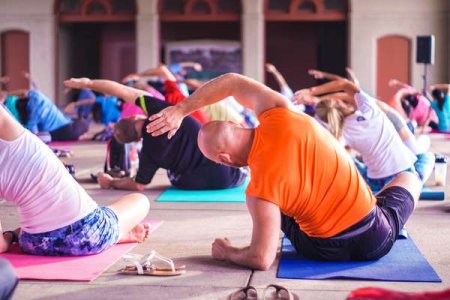Discover the secret to treating chronic pain without pills: Dr Cathy Stannard reveals all!
Living with chronic pain can feel like you're stuck on a never-ending rollercoaster, constantly seeking relief but only finding more disappointment and frustration. If you feel you're in the same boat, hang in there!
Dr Cathy Stannard, a former pain consultant and lead for NICE's chronic pain guidelines, reckons she's onto something that might just be your ticket to relief: exercise.
She's no stranger to the yearning for relief that's all too familiar to chronic pain battlers. Dr Stannard understands the temptation to cycle through a pharmacy's worth of pills, hoping for that magical cure.

Many of these medications, including antidepressants, are often handed out with the promise of alleviating pain. But, according to recent research, it turns out they might be promising more than they can deliver.
With the list of meds that have solid evidence of helping with chronic pain getting shorter, our health gurus have had to cast their nets elsewhere. And that's where exercise comes in. In all the confusion and uncertainty, Dr Stannard points out, there's one remedy the medical industry can firmly back: regular physical activity.
The thought of exercise may seem daunting or even impossible for some, but Dr Stannard speaks up against this notion, suggesting that it is achievable for everyone, no matter their age or level of mobility.
Dr Stannard recounts her experience with a pilot program in Gloucestershire, where she played an instrumental role in addressing chronic pain through exercise.
The program gave participants access to exercise instructors who assessed their individual abilities and tailored various exercises to suit their needs. From gentle stretches to climbing stairs and walking to local shops, the program offered a wide range of activities for participants to engage in.

Group sessions proved to be particularly beneficial, as they fostered a sense of camaraderie and motivation. Participants found that tailored advice and support from dedicated instructors made all the difference in their success.
Additionally, the program's cost-effectiveness was a bonus, with group sessions costing only £85 (approx. $158 AUD) per patient, compared to a much higher rate for outpatient consultant appointments.
As we move forward in rethinking the treatment of chronic pain, it's important to invest in programs that provide tailored exercise regimens and offer services that address additional issues contributing to pain, such as counselling, isolation, weight management, and debt.
These solutions promise a brighter, fuller, and happier life for chronic pain sufferers—without the unfortunate side effects of medications.
 So, let's heed Dr Cathy Stannard's advice and take charge of our health by embracing exercise as we walk hand-in-hand towards a remarkable pain-relief journey. Happy exercising!
So, let's heed Dr Cathy Stannard's advice and take charge of our health by embracing exercise as we walk hand-in-hand towards a remarkable pain-relief journey. Happy exercising!
Members, what's your take on Dr Stannard's advice? Could you give it a fair go and incorporate some exercise into your daily life?
Dr Cathy Stannard, a former pain consultant and lead for NICE's chronic pain guidelines, reckons she's onto something that might just be your ticket to relief: exercise.
She's no stranger to the yearning for relief that's all too familiar to chronic pain battlers. Dr Stannard understands the temptation to cycle through a pharmacy's worth of pills, hoping for that magical cure.

Scientists at the University Hospital of North Norway conducted a study involving 10,000 individuals, which revealed that engaging in even mild physical activity can enhance pain tolerance. Image by Fotorech from pixabay
Many of these medications, including antidepressants, are often handed out with the promise of alleviating pain. But, according to recent research, it turns out they might be promising more than they can deliver.
With the list of meds that have solid evidence of helping with chronic pain getting shorter, our health gurus have had to cast their nets elsewhere. And that's where exercise comes in. In all the confusion and uncertainty, Dr Stannard points out, there's one remedy the medical industry can firmly back: regular physical activity.
Exercise As A Game Changer
Last month, a study of 10,000 people conducted by researchers at the University Hospital of North Norway showcased the significant improvement exercise can bring to chronic pain sufferers' lives. Even light physical activity can increase pain tolerance and enhance quality of life.The thought of exercise may seem daunting or even impossible for some, but Dr Stannard speaks up against this notion, suggesting that it is achievable for everyone, no matter their age or level of mobility.
Dr Stannard recounts her experience with a pilot program in Gloucestershire, where she played an instrumental role in addressing chronic pain through exercise.
The program gave participants access to exercise instructors who assessed their individual abilities and tailored various exercises to suit their needs. From gentle stretches to climbing stairs and walking to local shops, the program offered a wide range of activities for participants to engage in.

Exercise has the potential to alleviate chronic pain and improve overall well-being. Image by mister_a from unsplash
Group sessions proved to be particularly beneficial, as they fostered a sense of camaraderie and motivation. Participants found that tailored advice and support from dedicated instructors made all the difference in their success.
Additionally, the program's cost-effectiveness was a bonus, with group sessions costing only £85 (approx. $158 AUD) per patient, compared to a much higher rate for outpatient consultant appointments.
The Result
The program successfully improved participants' quality of life and function and, to everyone's amazement, significantly reduced their pain. Dr Stannard's experience with this revolutionary program is a testament to the power of exercise in chronic pain management.As we move forward in rethinking the treatment of chronic pain, it's important to invest in programs that provide tailored exercise regimens and offer services that address additional issues contributing to pain, such as counselling, isolation, weight management, and debt.
These solutions promise a brighter, fuller, and happier life for chronic pain sufferers—without the unfortunate side effects of medications.
Key Takeaways
- Recent research has shown that most medications, including antidepressants, are largely ineffective for treating chronic pain.
- Exercise has been proven to be the most effective treatment for chronic pain, improving pain tolerance and overall quality of life.
- An Australian study found that paracetamol is also ineffective for chronic pain, along with stronger medications such as opioids and gabapentin.
- A pilot scheme in Gloucestershire, UK, involving tailored exercise programs for chronic pain patients has yielded substantial improvements in pain reduction and overall well-being.
Members, what's your take on Dr Stannard's advice? Could you give it a fair go and incorporate some exercise into your daily life?







